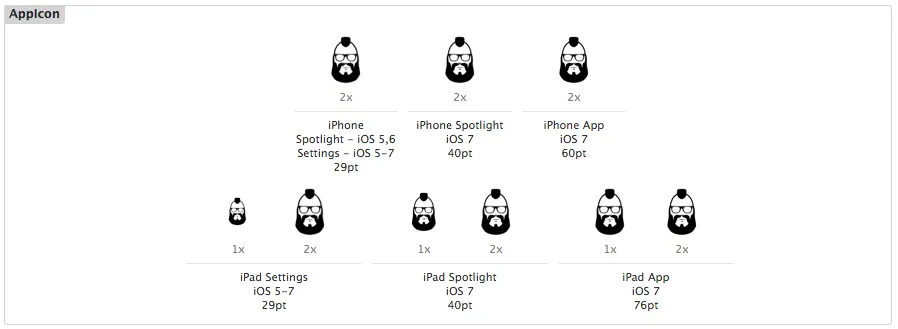我开始在iOS 6下编写这个应用程序,成功解决了与图像和弃用API相关的所有问题。
我正在创建一个新的图标以支持iOS 7风格,但无论我是使用资源目录还是直接路径到图像,只要我添加一个新的引用,每当我启动应用程序时,就会出现黑色图标。
显然我做错了什么。
这是我的资源目录,显示了所有映射的图像。它们实际上没有出现在应用程序中,我在所有iOS应用程序中都有黑色图标。

每次我启动时,都会得到一个黑色图标。这是否与Info.plist文件中的某些设置有关?
这是它的内容。
<?xml version="1.0" encoding="UTF-8"?>
<!DOCTYPE plist PUBLIC "-//Apple//DTD PLIST 1.0//EN" "http://www.apple.com/DTDs/PropertyList-1.0.dtd">
<plist version="1.0">
<dict>
<key>CFBundleDevelopmentRegion</key>
<string>en</string>
<key>CFBundleDisplayName</key>
<string>${PRODUCT_NAME}</string>
<key>CFBundleExecutable</key>
<string>${EXECUTABLE_NAME}</string>
<key>CFBundleIcons</key>
<dict/>
<key>CFBundleIcons~ipad</key>
<dict/>
<key>CFBundleIdentifier</key>
<string>com.neckbeardrepublic.${PRODUCT_NAME:rfc1034identifier}</string>
<key>CFBundleInfoDictionaryVersion</key>
<string>7.0</string>
<key>CFBundleName</key>
<string>${PRODUCT_NAME}</string>
<key>CFBundlePackageType</key>
<string>APPL</string>
<key>CFBundleVersion</key>
<string>1.0</string>
<key>LSRequiresIPhoneOS</key>
<true/>
<key>UIAppFonts</key>
<array>
<string>Lato-Black.ttf</string>
<string>FontAwesome.ttf</string>
</array>
<key>UIPrerenderedIcon</key>
<true/>
<key>UIRequiredDeviceCapabilities</key>
<array>
<string>armv7</string>
</array>
<key>UIStatusBarHidden</key>
<false/>
<key>UIStatusBarHidden~ipad</key>
<true/>
<key>UIStatusBarTintParameters</key>
<dict>
<key>UINavigationBar</key>
<dict>
<key>Style</key>
<string>UIBarStyleDefault</string>
<key>Translucent</key>
<false/>
</dict>
</dict>
<key>UISupportedInterfaceOrientations</key>
<array>
<string>UIInterfaceOrientationPortrait</string>
<string>UIInterfaceOrientationLandscapeLeft</string>
<string>UIInterfaceOrientationLandscapeRight</string>
</array>
<key>UISupportedInterfaceOrientations~ipad</key>
<array>
<string>UIInterfaceOrientationLandscapeLeft</string>
<string>UIInterfaceOrientationLandscapeRight</string>
</array>
<key>UIViewControllerBasedStatusBarAppearance</key>
<false/>
</dict>
</plist>
非常令人沮丧。我刚刚尝试提供具体文件,但也没有多大帮助。
有人能确定问题所在吗?
CFBundleIcons下面,你有拖放它们吗? - meda